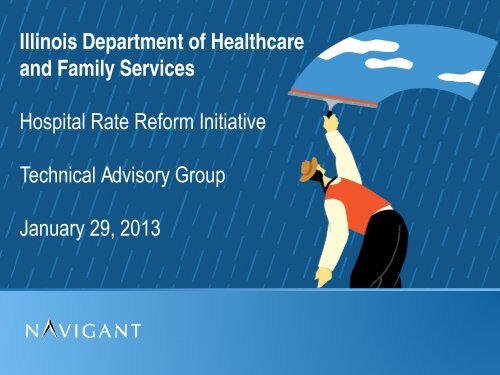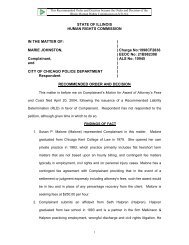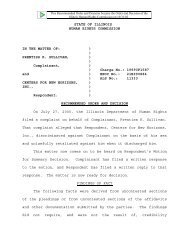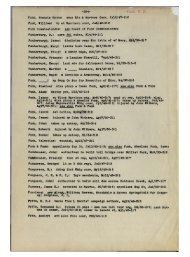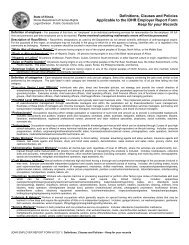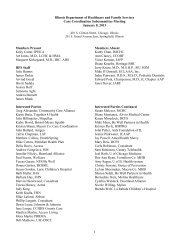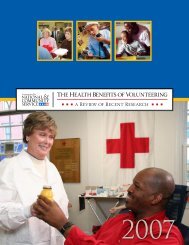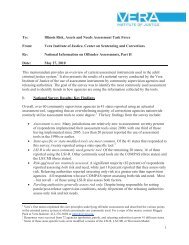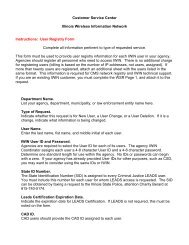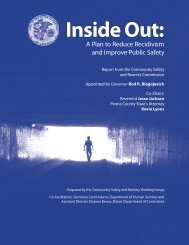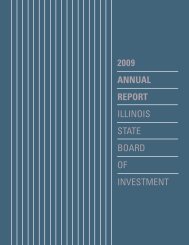Create successful ePaper yourself
Turn your PDF publications into a flip-book with our unique Google optimized e-Paper software.
<strong>Illinois</strong> Department <strong>of</strong> Healthcareand Family ServicesHospital Rate Reform InitiativeTechnical Advisory GroupJanuary 29, 2013
Meeting AgendaAgendaRevised Inpatient Model with Policy AdjustersShadow Pricing ModelsTAG Requested AnalysesAlternative Inpatient Model UpdateCoding Improvement / Transition PeriodQuestions and DiscussionPage 2
Revised Inpatient Model withPolicy Adjusters
Revised Inpatient Model With Policy AdjustersRevised Model assumptions» Effective July 1, 2013, HFS will replace its current Medicaid FFS inpatientCMS DRG version 12 and per diem payment methodology with a newAPR-DRG-based payment system› At implementation, the new APR-DRG system will not replace staticpayments, MPA/MHVA payments or LTAC add-on payments» Based on review <strong>of</strong> the “Baseline” model and input from the TAG, HFS isevaluating a revised model with:› Policy adjusters that increase payments for key Medicaid <strong>services</strong>› “Flat” per diem rate for specialty <strong>services</strong> (psychiatric, rehabilitationand LTAC <strong>services</strong>) that removes the acuity and graduated dayadjustments from the pricing formulaPage 4
Revised Inpatient Model With Policy AdjustersRevised Model assumptions (continued)» Revised model uses SFY 2009 claim-based payments net <strong>of</strong> DSH, MPA/MHVA, andLTAC add-on payments as basis for APR-DRG system funding pool› Used SFY 2009 data to facilitate data reconciliation with IHA› Claim reported payments used for DRG funding pool do not reflect SMART Actreductions› LTAC per diem payments under current system simulated for a provider paid underDRGs in SFY 2009› Static payments excluded from DRG funding pool» Modeled rates are designed to make each category <strong>of</strong> service budget neutral to currentsystem claim DRG / per diem paymentsPage 5› COS 20 – <strong>Acute</strong>› COS 21 – Psychiatric› COS 22 – Rehabilitation› COS 20 – LTAC
Revised Inpatient Model With Policy Adjusters<strong>Acute</strong> <strong>services</strong>» For COS 20 acute <strong>services</strong>, revised model components include:› APR-DRG version 29 3M national relative weights re-centerscaled to 1.0 for <strong>Illinois</strong> Medicaid case mix› <strong>State</strong>wide standardized base rate <strong>of</strong> $4,193.48, with labor portionadjusted for FFY 2012 Medicare IPPS wage index› Medicare outlier policy, with $22,385 fixed stop loss, and 80%marginal cost percentage› Medicare standard transfer-out policy (without post-acute transferpolicy) – prorated payment for cases with length <strong>of</strong> stay less thanAPR-DRG average› No direct or indirect medical education paymentsPage 6
Revised Inpatient Model With Policy Adjusters<strong>Acute</strong> <strong>services</strong>» Baseline model (without policy adjusters) projected a $35.7 milliondecrease in payments (6.6% reduction) for newborn and obstetrical<strong>services</strong> combined› HFS and the TAG recognize that newborn and obstetrical <strong>services</strong> are critical tothe Medicaid program and have a high Medicaid market share› TAG requested that HFS evaluate a policy adjuster for these <strong>services</strong>» To maintain access to these <strong>services</strong>, HFS, with support <strong>of</strong> the TAG, isconsidering a policy adjuster that would maintain current systemfunding levels for newborn and obstetrical <strong>services</strong> combinedPage 7
Revised Inpatient Model With Policy Adjusters<strong>Acute</strong> <strong>services</strong> (continued)» Policy adjuster <strong>of</strong> 15% applied to DRG base payments fornewborn/OB <strong>services</strong> as follows:› Normal newborn DRGs: identified based on APR-DRGs 626 and 640› Neonate DRGs: identified based on non-normal newborn DRGs in MDC 15(Newborns and other neonates with condition originating in perinatal period)› Obstetric DRGs: identified based on MDC 14 (Pregnancy, childbirth and thepuerperium)» <strong>Acute</strong> pediatric <strong>services</strong> were also evaluated, but because these<strong>services</strong> already had a projected payment increase, no policyadjuster was applied in the modelPage 8
Revised Inpatient Model With Policy AdjustersPsychiatric <strong>services</strong>» For COS 21 psychiatric <strong>services</strong>, revised model components include:› Psychiatric-specific standardized per diem rate <strong>of</strong> $366.45,adjusted for FFY 2012 Medicare IPF-PPS wage index and ruralstatus› Removed relative weight and graduated day adjustments» Baseline model (without policy adjusters) projected a $19.6 milliondecrease in payments (23.0% reduction) for pediatric psychiatric<strong>services</strong>› Policy adjuster <strong>of</strong> 30% applied to per diem payments forpsychiatric pediatric <strong>services</strong> to maintain current funding levelsPage 9
Revised Inpatient Model With Policy AdjustersRehabilitation <strong>services</strong>» For COS 22 rehabilitation <strong>services</strong>, revised model components include:› Rehabilitation-specific standardized per diem rate <strong>of</strong> $597.93,adjusted for FFY 2012 Medicare IRF-PPS wage index and ruralstatus› Removed relative weight adjustments» Baseline model (without policy adjusters) projected a $1.3 milliondecrease in payments (20.3% reduction) for pediatric psychiatric<strong>services</strong>› Policy adjuster <strong>of</strong> 30% applied to per diem payments forrehabilitation pediatric <strong>services</strong> to maintain current funding levelsPage 10
Revised Inpatient Model With Policy AdjustersLTAC <strong>services</strong>» For COS 20 LTAC <strong>services</strong>, revised model components include:› LTAC-specific standardized per diem rate <strong>of</strong> $593.79, adjusted forFFY 2012 Medicare IPPS wage index› Removed relative weight adjustments» Since virtually all LTAC claims were adult, no pediatric policy adjusterwas applied in the modelPage 11
Shadow Pricing Models
Shadow Pricing ModelsShadow Pricing Assumptions – Partial SFY 2013 Claim Data» To evaluate the new system using the most recent claims dataavailable (and as required by the SMART Act), HFS has re-priced92,093 SFY 2013 FFS claims under the Revised Model payment ratesand methodology› Claims with an admission dates starting July 1, 2012 and discharges dates on orbefore December 14, 2012» SFY 2013 claim reported payments reflect 3.5% SMART Act reductions› For comparison purposes, 3.5% SMART Act reductions applied to simulated newsystem payments› Simulated new system payments were compared to reported claim payments net<strong>of</strong> DSH, MPA/MHVA and LTAC add-onsPage 13
Shadow Pricing ModelsShadow Pricing Assumptions – Full SFY 2011 Claims Data» To evaluate the new system using the most fully mature and completestate fiscal year <strong>of</strong> claims data available, HFS has re-priced SFY 2011FFS claims under the Revised Model payment rates and methodology» SMART Act reductions had not yet occurred in SFY 2011› As such, for comparison purposes, 3.5% SMART Act reductions were not appliedto simulated new system payments› Simulated new system payments were compared to reported claim payments net<strong>of</strong> DSH, MPA/MHVA and LTAC add-onsPage 14
Shadow Pricing ModelsShadow Pricing Assumptions – SFY 2011 Claims (Continued)» Revised Model rates applied to SFY 2011 FFS claims data resulted in simulatednew system payments that are lower than current system payments:Category <strong>of</strong>ServiceDRG/PerDiemPaymentsSFY 2011 Claims DataReported PaymentsOutlierPaymentsTotal ClaimPayments(Net <strong>of</strong>DSH/MPA)Revised Model Rates Appliedto SFY 2011 Claims DataDRG/PerDiemPaymentsOutlierPaymentsTotal ClaimPayments(Net <strong>of</strong>DSH/MPA)EstimatedPaymentChange<strong>Acute</strong> COS 20 Services $1,261.2 $610.4 $1,871.6 $1,543.2 $249.1 $1,792.2 -$79.4Psychiatric COS 21 Services $160.9 $0.0 $160.9 $153.4 $0.0 $153.4 -$7.5Rehabilitation COS 22 Services $31.2 $0.1 $31.3 $30.7 $0.0 $30.7 -$0.6LTAC COS 20 Services $46.1 $6.5 $52.5 $37.3 $0.0 $37.3 -$15.2Inpatient Total $1,499.3 $617.0 $2,116.3 $1,764.5 $249.1 $2,013.6 -$102.7Page 15
Requested TAG Analyses
Requested TAG AnalysesRequested analyses from prior TAG meeting» Consider model version that maintains current system outlierpayment levels» Evaluate model results for transplant <strong>services</strong>» Evaluate model results for teaching hospitals» Evaluate model results for providers with high capital expenditures» Consider cost-based LTAC payment ratesPage 17
Requested TAG Analyses“Current Outlier Level” Approach» Alternative model requested to maintain outlier payments at current levels foracute <strong>services</strong> ($471.4 million for SFY 2009 acute COS 20 claims):AlternativeModelVersionOutlierPayments(Using SFY2009 Claims)OutlierPayment % <strong>of</strong>Total DRGPaymentsModeledOutlier FixedLossThresholdModeledOutlierMarginalCost FactorPercent <strong>of</strong> <strong>Acute</strong>COS 20 Claimswith SimulatedOutlier PaymentCurrent System $471.4 million 27.2% $28,981(SFY 2009 average)Revised Model withPolicy Adjusters0.80 5.7%$251.4 million 14.5% $22,385 0.80 2.3%Alternative Baseline Model 1 $471.4 million 27.2% $6,475 0.80 10.9%Alternative Baseline Model 2 $471.4 million 27.2% $8,537 0.90 8.0%Alternative Baseline Model 3 $471.4 million 27.2% $22,385 1.457 2.4%Page 18
Requested TAG AnalysesTransplant Service Evaluation» Current inpatient methodology pays 60% <strong>of</strong> charges for transplants(except for kidneys, which are paid under DRGs)» Policy Adjuster Model using SFY 2009 data simulates a per dischargeDRG payment plus outlier for transfer cases› 27.1% modeled pay-to-charge ratio for transplants (using inflatedcharges) under new system compared to 21.8% for acute <strong>services</strong>overallPage 19
Requested TAG AnalysesMedical Education Evaluation» Current inpatient methodology does not include separate claim-based direct or indirectmedical education payments; IME factor used to reduce outlier payments whencalculating claim costs» In the Revised Model (using SFY 2009 data), the 10 in-state general acute teachinghospitals with the highest FFY 2013 Medicare intern-to-bed ratio have a projected a$26.0 million combined payment increase (6.5% change) for acute <strong>services</strong>› 8 hospitals with a projected gain, 2 with a projected loss» In the Revised Model (using SFY 2009 data), the 10 in-state general teaching hospitalswith the highest Medicaid direct medical education costs (based on SFY 2009 claims)have a projected $23.3 million combined payment increase (3.9% change) for acute<strong>services</strong>› 6 hospitals with a projected gain, 4 with a projected lossPage 20
Requested TAG AnalysesCapital Cost Evaluation» Current inpatient methodology includes a capital per discharge add-onpayment (not acuity or length <strong>of</strong> stay adjusted)» In the Revised Model (using SFY 2009 data), the 10 in-state generalacute hospitals with the highest Medicaid capital costs (based on SFY2009 claims) have a projected $28.4 million combined paymentincrease (4.8% change) for acute <strong>services</strong>› 6 hospitals with a projected gain, 4 with a projected lossPage 21
Requested TAG AnalysesLTAC Cost-Based Rate Evaluation» LTAC provider cost per day distribution using SFY 2009 claims data(current LTAC per diem rate is $604):Page 22LTAC ProviderLTAC Provider EstimatedSFY 2013 Cost Per Day(Without Assessment Cost)1 $ 1,215.062 $ 1,314.283 $ 1,405.084 $ 1,698.185 $ 2,034.246 $ 2,162.64Weighted Average $1,309.28
Alternative Inpatient Model Update
Transitional Corridor
Transitional CorridorPage 25Example Transitional Corridor Period» Payments are made through DRG methodology» Transition is created through adjustment to hospital base rates» Prospectively limit individual hospital’s estimated payment changepercentage to:› +/- 5% in year 1› +/- 10% in year 2› +/- 15% in year 3› Rebase using claims paid under APR-DRGs and coded under ICD-10 inyear 4» Will allow hospitals time to adjust, improve efficiency, and reducecost growth» Actual transition period may differ from example
Questions and Discussion


